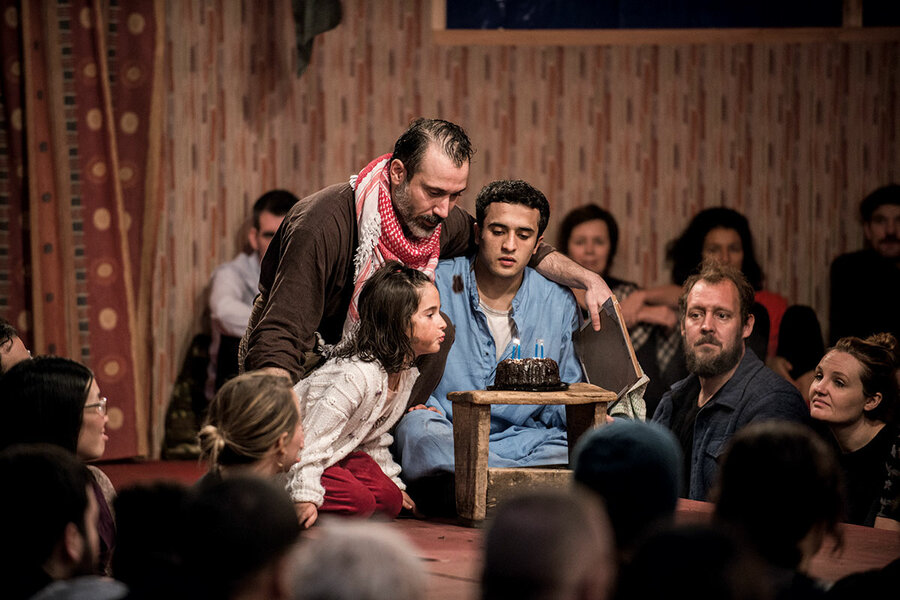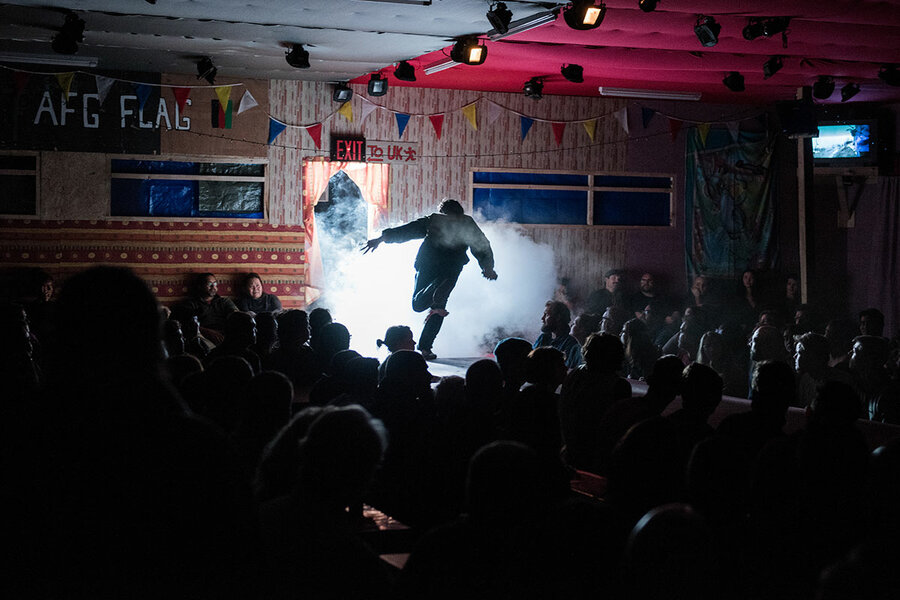Theater vérité: How ‘The Jungle’ re-creates a refugee encampment
Loading...
| New York
During performances of “The Jungle” at St. Ann’s Warehouse in New York, theatergoers are inches from the action – and are sometimes handed freshly made food.
“The Jungle” isn’t dinner theater, though. Nor is it connected to the novel by Upton Sinclair about Chicago’s stockyards. Instead it’s a heavyweight drama about the migrant camp in Calais, France – called “the Jungle” – which was demolished by authorities in 2016.
Why We Wrote This
A story focused onWhat role do the arts play in debates about immigration? With “The Jungle,” a pair of playwrights immerse people in the migrant camp experience, aiming to prompt more discussion and understanding.
The play, back in the U.S. starting Feb. 18, attempts to re-create the experience of living in that camp by placing ticket holders right in the middle of it. Sometimes it’s harrowing: Early on, fake tear gas billows through the flaps of the set’s tent. But it is also heartwarming and hopeful. By putting the audience in such close proximity to the characters, “The Jungle” aims to bring more understanding to the migrant experience.
“What I love about this play is that we don’t try to solve the problem,” says Ben Turner, who plays an Afghan refugee turned restaurant proprietor. “We’re not trying to wrap everything up in a bow. It’s messy. ... The characters are contradictory. They love, they hate, they unite. They have preconceived ideas and judgments towards each other. But then they come together in the best way.”
For the next month, when ticket holders enter St. Ann’s Warehouse in New York, they won’t see a conventional stage with rows, arcs, or circles of chairs. Just a vast tent.
It’s the setting for “The Jungle,” an immersive theater production. The tent is a makeshift restaurant inside a refugee camp. There’s dirt underfoot. Long tables with benches for seating and ketchup at every place setting await audience members. Ushers guide them to their places via the set’s kitchen area, which includes a dusting of flour that is more than just a prop.
“Some lucky people get some freshly made naan,” says Naomi Webb, executive director of Good Chance Theatre, the British company that created the show, opening Feb. 18. “It depends on where you sit.”
Why We Wrote This
A story focused onWhat role do the arts play in debates about immigration? With “The Jungle,” a pair of playwrights immerse people in the migrant camp experience, aiming to prompt more discussion and understanding.
“The Jungle” isn’t dinner theater, though. Nor is it connected to the novel by Upton Sinclair about Chicago’s stockyards. Instead it’s a heavyweight drama about the migrant camp in Calais, France – called “the Jungle” by some – which was demolished by authorities in 2016. The play attempts to re-create the experience of living in the refugee camp. Sometimes it’s harrowing: Early on, fake tear gas billows through the flaps of the tent. But it is also heartwarming and hopeful. By putting the audience in such close proximity to the characters, whose stories play out on runway-style stages surrounded by the restaurant tables, “The Jungle” aims to bring more understanding to the migrant experience.
“Since the Jungle got dismantled, there’s been hardly any kind of media attention to what’s happening in Calais,” says Elena Ewence, a volunteer with Project Play, a nonprofit that gives displaced children in the area, and nearby Dunkirk, spaces and opportunities for recreation. “So the fact that [“The Jungle”] is being shown is really important because a lot of people aren’t aware of what’s going on. ... It’s really easy to forget these are real human beings.”
“The Jungle” tells the intersecting stories of several individuals who aspire to cross the channel to Britain, about 30 miles from the port of Calais. Whether by boat or tunnel, it’s a risky journey. So thousands of people set up tents and shacks in the rapidly expanding camp. Soon after an Afghan man named Salar (Ben Turner) creates his restaurant, he hosts a sort of town-hall meeting in the tent. Representatives for various enclaves – including Eritreans, Kurds, Sudanese, and Syrians – discuss how to quell violent clashes between refugees. The situation is complicated by the arrival of well-meaning, but often naive, aid workers from Britain.
“There is a big, big, big question in the play ... which is, ‘Can we live together?’” says Ammar Haj Ahmad, a Syrian actor who plays the optimistic narrator, before a recent rehearsal. “My character, at the beginning, says, ‘It takes pain to live side by side.’ And at the end of the play, he says, ‘Well, it takes pain to live side by side. It takes even more to live alone.’”
When “The Jungle” debuted in London in 2017, it was widely praised for its complexity and nuance. Call it theater vérité. Playwrights Joe Murphy and Joe Robertson based the drama on their own experiences of living in the encampment. Ms. Webb says that the British duo were en route to Munich via Calais when they visited the camp.
“They met a group of guys who said, ‘Oh, come and sit with us,’” says Ms. Webb, who later also spent time in the camp. “They played some music together and shared the story about their journey. They stayed for a week and met so many people. … And they really had a sense that everybody there really wanted to talk about what had happened to them and [tell] the stories and the journeys that they’ve been on.”
The playwrights later returned to the United Kingdom and raised money to purchase a portable geodesic dome to establish the Good Chance Theatre in the camp. (The same dome, tagged with graffiti, is mounted at the rear of St. Ann’s Warehouse where it functions as a backdrop to the set as well as a backstage area for the actors.) The cast of the first production in London in 2017 included several refugees from the camp. Some of the original cast members, including Mr. Turner and Mr. Haj Ahmad, have returned for this production of “The Jungle,” which is once again co-directed by television and theater veterans Stephen Daldry (“The Crown,” “Billy Elliot”) and Justin Martin (“The Crown,” “Prima Facie”).
“One of the first questions I asked about doing it this time around was, ‘What is the show now?’” says Mr. Turner, sitting next to a window with a view of the underside of the Brooklyn Bridge. “Stephen and Justin, after watching the show, one of the run throughs, said that actually all the narratives within the show that have always been there are suddenly feeling a lot more relevant. Like the Afghan story in this show, because of what’s going on in Afghanistan at the moment, suddenly seems to hit in a different way.”
“The Jungle,” which had a previous engagement at St. Ann’s Warehouse in 2018, takes on a different context and timbre depending on the city. The production sometimes includes question-and-answer sessions at the end of the play. When it played in San Francisco in 2019, audiences saw parallels between the characters in the story and the Bay Area’s homeless population. This time around, Ms. Webb expects there will be conversations about migrants who have been bused from Southern border states to New York. Good Chance is partnering with the Brooklyn Community Foundation’s Immigrant Rights Fund to raise money to support its work.
Ms. Ewence, from Project Play, says a person she knows who saw the play called it “very, very powerful.” “I believe it partially inspired them to come [to Calais] and volunteer.”
The honesty of the emotions opens the hearts of the audience, says Mr. Haj Ahmad, a Syrian refugee who did not experience the camp in Calais. He says he feels changed each time he performs the show.
Ruth Yemane, a new cast member, adds, “The thing with refugees in general is they’re demonized and people see them as kind of a burden. ... But I think in this play, it does a really good job of showing each individual and their journey and making them human and creating that connection.”
The characters have to bridge their own divides. For example, Mr. Turner’s Afghan character, who has a background as a lawyer, comes to discover common ground with an Eritrean woman as well as an upper-class British volunteer. The microcosm within the camp can also be viewed as a proxy for the wider issue of harmoniously integrating migrants in their new countries.
“What I love about this play is that we don’t try to solve the problem,” says the actor. “We’re not trying to wrap everything up in a bow. It’s messy. Corners are blurred. There’s a whole lot of gray. It’s not black and white. It’s contradictory. The characters are contradictory. They love, they hate, they unite. They have preconceived ideas and judgments towards each other. But then they come together in the best way.”
“The Jungle” runs at St. Ann’s Warehouse in New York from Feb. 18 through March 19, and then is at Harman Hall in Washington, D.C., from March 28 through April 16. Due to mature content, “The Jungle” is recommended for ages 12 and above.










